Final report for GNE15-102
Project Information
The purpose of this project was to extend the dairy grazing season with fall intercropped forage radish (FR), and oats. In September 2015, 2016, and 2017, six ratios of FR to oat were planted after manure application in order to study yield potential, land equivalent ratios (LER), nutrient capture from fall applied manure, glucosinolate (GL) content of different rations, and changes to free-living and plant parasitic nematode populations in the soil. Our holistic approach capitalized on the dual-purpose capabilities of cover crops to manage soil health while providing economic value through additional forage production. We aimed to optimize yield and feed value of fall forage production, while maximizing nutrient removal of N&P from fall-applied manure. We also aimed to encourage populations of free-living nematodes while minimizing plant-parasitic nematodes. Our overarching goal was to develop a system that facilitates economic gains through sustainable management practices using dual-purpose cover crops, and to encourage growers to increase cover crop usage following fall manure application.
In order to assess the effects of different seeding ratios for these cover crop mixtures/ intercrops, we planted FR and oat at four ratios compared to sole crops of each. From this, we assessed FR shoot, root, and oat above ground biomass for yield, N capture, P capture, RFV, GLS production, FR population, and nematode population changes under each planting ratio. This work was presented at numerous research, education, and Extension events. Growers, small-scale producers, community members, educators, researchers, and agricultural service providers all attended a variety of events and outreach activities.
Chiefly, we find that mixtures serve as better cover crops as well as forage crops compared to monocultures. We also find that cover crop mixtures, regardless of their dual-purpose potential, should be considered from an intercropping perspective. Some results were unexpected and notably non-linear in accordance with the seeding ratio. These relationships and critical implications are likely to be missed if the effects of interspecific and intraspecific competition are not integrated into the overall evaluation of mixture performance.
Individual Objectives
- Determine the (LER) of FR and oats
- Determine the ratio of FR and oats with the greatest RFV
- Assess levels of GL in each ratio
- Define changes to GL levels across individual plants to determine the effect, if any, of planting ratios on GL production
- Measure crop N&P capture from fall applied manure
- Identify changes to free-living and plant-parasitic nematode populations under different planting ratios.
Overall Objectives
- Reconcile yield, RFV, GL content, effects on nematode populations, and nutrient capture to determine the optimum FR to oat planting ratio for use as a dual-purpose fall cover crop and grazing crop.
- Conduct outreach to disseminate information and recommendations through individual communication, dairy meetings, research conferences, annual field day events, newsletters, and factsheets.
In the Northeast, our short growing seasons, long winters, changing climate, environmental concerns, and fluctuating economy give Northeastern dairy farmers many factors to contend with while managing profitable operations. While 2013 showed gains in milk prices, the dairy market is historically volatile (Laughton, 2014), and production costs are rising (New England Milkshed Assessment, 2012). Developing strategies that help dairy farmers maintain their resiliency serves to strengthen both the economy and food security of the Northeast.
To feed their animals, most regional dairy farmers largely rely on corn grown for silage and pasture grazing. When grazing is unavailable and stored forage is limited, farmers supplement with purchased feed. For most dairy operations, feed is the largest annual expense. In 2011, feed expenses increased by over $300/animal, reaching $1578/animal (New England Milkshed Assessment, 2012). In 2012, this cost increased by $189 to $1,767/animal (Lidback and Laughton, 2013), and in 2013 an $82 increase brought the total to $1,849/animal (Laughton, 2014). Production cost increases are accompanied by significant fluctuations in product value. Farmers who can sustain these oscillations, and accommodate increased feeding costs, are more likely to experience long-term success. Fall forage production systems can reduce reliance on purchased feed, resulting in monetary savings for farmers. Fall intercropping of FR and oats offers great season extension potential because these crops quickly establish, tolerate dropping temperatures, and are hearty nutrient scavengers; they also combine to produce a balanced forage.
In addition, dairy farmers traditionally empty their barns and apply manure to their fields in the fall. N & P can be introduced to the surrounding environment through leaching, erosion, and run-off, which substantiates environmental concerns associated with manure applications (Eghball and Gilley, 1999), and wastes these nutrients as they are no longer available for crops. Fall forage plantings provide environmental contributions by doubling as cover crops and capturing fall-applied manure nutrients. Up to 46% of N is lost from fall-applied manure if catch crops are not quickly planted, as demonstrated by Farsad et al.’s six-year study (2011). Furthermore, Cisek et al., (2015) demonstrated that grazed, fall catch crops can significantly reduce leaching of NO3-N. Fall plantings after manure application mitigate nutrient loss due to fixation and leaching.
Forage radish (FR) and oats are suitable fall cover crops, each offering upwards of 3500 lbs/DM/acre in monocultures. This production is in addition to forage produced in the summer growing season, usually corn, therefore increasing total, annual forage production. The low crude protein, but high NDF of oats are well balanced with the high crude protein and low NDF of forage radish in a mixed ration (Hensen et al., 2013). Intercropping these nutrient scavengers may result in greater land use efficiency, LER, as they may demonstrate the characteristics of other intercropping systems, such as winter peas and wheat, exploiting available nutrients more efficiently than in monocultures (Lithourgidis et al., 2011). In addition to feed and nutrient capture benefits, after grazing, the remaining root systems of these crops prevent soil erosion throughout the winter. Spring decaying roots support microbial populations and mineralization, providing nutrients to subsequently planted crops (Tonitto et al., 2006).
The economic potential of significant fall yields of quality forage, coupled with the sustainable benefits of soil health management and nutrient capture, makes fall intercropping with oat and FR a desirable practice. However, forage radish produces glucosinolates, GLS, as secondary metabolites. The hydrolysis of the GLS to toxic compounds, including isothiocyanates, ITCs, can result in decreased palatability, and therefore decreased consumption and milk production (Tripathi and Mishra, 2007). On the contrary, ITCs offer benefits in soil nematode management, as they may be toxic to plant parasitic nematodes feeding on forage radish roots, potentially reducing parasitic populations (Hallman et al., 2009). Brassicaceous cover crops have been shown to affect free-living nematode populations as well, sustaining bacterivores that feed on bacteria that mineralize nitrogen (Gruver et al., 2010).
We aimed to develop feed rations low in glucosinolates, GLS, which are naturally hydrolyzed by an endogenous enzyme into toxic compounds upon tissue mastication or decomposition. While ruminants can metabolize these compounds, cows and their nursing offspring can experience adverse reactions to high levels of FR consumption due do these hydrolyzed products. Reactions include induced iodine deficiency, thyroid disorders, and reduced fertility. Excessive GLS content also results in decreased palatability, and therefore decreased consumption and milk production (Tripathi and Mishra, 2007). By balancing the ratio of FR to oat we can minimize GLS content to further improve the quality and palatability for the animals. In addition to quantifying GLS in each ration, we sought to measure differences in total GLS among individual plants under different planting ratios. From this, we can assess the potential of intercropping to increase or decrease GLS concentrations in FR as an effect of competition.
Overall, this research aimed to provide information and incentives that encourage adoption of sustainable and profitable grazing season extension.
Literature Cited
Cicek, H., Martens, J., Bamford, K., & Entz, M. (2015). Late-season catch crops reduce nitrate leaching risk after grazed green manures but release N slower than wheat demand. Agriculture, Ecosystems & Environment, 20231-41.
Eghball, B., & Gilley, J. (1999). Phosphorus and nitrogen in runoff following beef cattle manure or compost application. Journal Of Environmental Quality, 28(4), 1201-1210.
Farsad, A., Herbert, S., Randhir, T., & Hashemi, M. (2011). Spatial modeling of critical planting date for winter rye cover crop to enhance nutrient recovery. Agronomy Journal, 103, 1252-1257.
Gruver, L., Sardanelli, S., Momen, B., Weil, R., & Zasada, I. (2010). Brassicaceous and rye cover crops altered free-living soil nematode community composition. Applied Soil Ecology, 45(1), 1-12.
Hansen, M., Owens, V., Beck, D., & Sexton, P. (2013). Suitability of cover crop monocultures for late-season forage in South Dakota. Canadian Journal Of Plant Science, 93(4), 589-597.
Hallmann, J., Daub, M., Schütze, W., & Schlathölter, M. (2009). Biofumigation against plant nematodes. Gemüse (München), 45(2), 19-21.
Kleinman, P., Salon, P., Sharpley, A., & Saporito, L. (2005). Effect of cover crops established at time of corn planting on phosphorus runoff from soils before and after dairy manure application. Journal Of Soil And Water Conservation, 60(6), 311-322.
Lidback, J., Laughton, C. (2012). 2011 Northeast Dairy Farm Summary (Publication). Farm Credit East, ACA. Retrieved from: http://www.dairychallenge.org/pdfs/2011_Northeast/ 2011DairyFarmSummary.pdf
Laughton, C. (2014). 2013 Northeast Dairy Farm Summary (Publication). Farm Credit East, ACA. Retrieved from: https://www.farmcrediteast.com/~/media/Files/Knowledge%20Exchange/ Dairy%20Farm%20Summary/2013%20DFS%20final.ashx
Lithourgidis, A., Vlachostergios, D., Dordas, C., & Damalas, C. (2011). Dry matter yield, nitrogen content, and competition in pea–cereal intercropping systems. European Journal Of Agronomy, 34(4), 287-294.
New England Milkshed Assessment: State-level Programs and Policies Helping to Sustain the Region's Dairy Farms and State and Federal Policy Recommendations (2012). American Farmland Trust.
Tonitto, C., David, M., & Drinkwater, L. (2006). Replacing bare fallows with cover crops in fertilizer-intensive cropping systems: a meta-analysis of crop yield and N dynamics. Agriculture, Ecosystems & Environment, 112(1), 58-72.
Tripathi, M., & Mishra, A. (2007). Glucosinolates in animal nutrition: A review. Animal Feed Science And Technology, 132(1-2), 1-27.
Cooperators
Research
Experimental Site
The three-year experiment was conducted at the Crops and Animal Research and Education Center of the University of Massachusetts in South Deerfield, MA (42° N, 73° W). The soil at the site is classified as a Hadley Loam (Coarse-silty, mixed, superactive, nonacid, mesic Typic Udifluvents). The experimental plot in 2015 and 2016 did not have a history of manure application, while the experimental plot in 2017 previously received manure in the fall of 2014.
Experimental Design
Manure was applied at a rate of 8000 gal/A, disked to incorporate, and FR and oats were subsequently planted with a seven-row plot cone seeder at six different seeding ratios (FR: oat) in a complete randomized bock design, with a bare control plot included in each replication. Plots were 15x15 feet and comprised of 21 rows each. Three replications were planted each year for a total of nine replications. Crops were seeded on September 5th in 2016 and 2017, and September 11th in 2018 due to wet weather. Notably, in 2017 manure digestate – as opposed to liquid manure – was used. The primary seeding rates under investigation were seeding rates 2 – 5, rate 1 (no FR) and 6 (all FR) serve as negative and positive controls.
- 0:100
- 10:90
- 20:80
- 30:70
- 40:60
- 100:0
- Control - bare
A soil N & P baseline was collected before and after manure application from the top eight inches. Three individual soil samples were taken from the top eight inches of each end of the season for N & P analysis. Two, two linear feet tissue samples for yield, RFV, N, and P were collected following the first frost and before winterkill. Nematode samples were also collected at a depth of eight inches, 15 samples per plot, taken before planting, at the end of the fall, and in the early spring to monitor population changes as influenced by the dual-purpose cover and forage crop. Nematodes were identified by morphology via light-microscopy.
Tissue N was measured using the Kjeldahl digestion method (Bremner, 1996) while P was measured after ashing at in a Furnatrol 53600 furnace at 500 C for a minimum of 5 hours. Tissue samples were assessed using NIR (Near-infrared spectroscopy ) to determine the RFV. Soil P was extracted in Modified Morgan, while soil N was extracted in calcium chloride. Soil and tissue N & P were all measured on a Lachat Quikchem 8500.
Two plants were randomly harvested from each planting ratio for GLS analysis. Plants were immediately processed in liquid N and stored at -80 C until analysis. GLS were extracted using a modified protocol adapted from Grosser and van Dam, 2017, and Mewis et al. 2006. Extracts will be quantified using HPLC (high performance liquid chromatography) according to the retention time and quantification of internal GLS standard, sinigrin hydrate. From this information, we will determine GLS concentrations in individual plants under each ratio. The total content found in each planting ratio determines how much GLS is consumed in one day’s ration by dairy cows, which will be compared against veterinary recommendations.
Weather Considerations
Average annual precipitation at this experimental site ranges from 37-51 inches. Weather conditions were favorable in 2015 up until an early and severe freeze event. The 2016 season followed a severe summer-long drought that continue into the early fall. Despite dry conditions, the experiment was located at the bottom of a sloping field and therefore was subject to frequent and substantial moisture – including pooling water in some plots – when we received rain. There were no notable environmental effects in 2017.
Method References
Bremner, J.M. (1996) Nitrogen—Total. Methods of soil analysis. Part 3. Chemical methods. SSSA Book Ser. 5. SSSA, Madison, WI. p. 1085–1121.
Grosser, K., & van Dam, N. M. (2017). A Straightforward Method for Glucosinolate Extraction and Analysis with High-pressure Liquid Chromatography (HPLC). Journal of Visualized Experiments : JoVE, (121), 55425. Advance online publication. http://doi.org/10.3791/55425
Mewis, I., Tokuhisa, J. G., Schultz, J. C., Appel, H. M., Ulrichs, C., & Gershenzon, J. (2006). Gene expression and glucosinolate accumulation in Arabidopsis thaliana in response to generalist and specialist herbivores of different feeding guilds and the role of defense signaling pathways. Phytochemistry, (22), 2450.
Overall Yield
All mixed plots yielded more than sole crops of both FR and Oat (Fig 1), although the 30% planting ratio was equal to the FR monoculture. The 20% and 40% planting ratios were comparable in yield at nearly 2 tons of dry matter per acre each, on average over three years. This result is expected as we commonly find that intercropping results in greater yields per land unit than sole cropping. This generally occurs due to better resource utilization and differential niche occupation in the intercrop. This trend is reinforced by the LERs (Fig 2) of each planting ratio.
Fig One: Total yield by treatment and crop, averaged across all three experimental years.
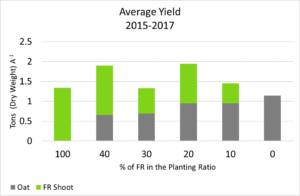
LER and Intercropping Considerations
Fig Two: Land equivalent ratio (LER) of each treatment, averaged across all three experimental years.
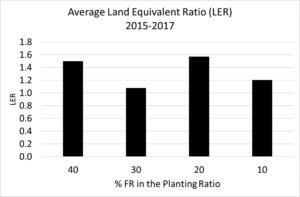
In all cases, the LER is greater than one, which indicates an intercropping advantage - i.e. greater yield per land unit - compared to monocultures. The greatest LER coincides with the largest yield, which occurs when FR is planted at 20% in a mix with oat planted at 80%. Surprisingly, of the four planting ratios, the lowest yield and LER occurs when FR is planted at 30% in a mix with oat planted at 70%. This reduction in yield was observed in each year of the experiment. At this ratio, FR in particular shows a reduced yield compared to when it is planted at 40% or 20%.
Figure Three: Percentage of the total yield from each component crop by treatment.

In all seeding ratios, FR accounted for significantly more of the biomass in the total yield than the percentage at which is was planted (Fig 3). For example, when FR was planted at 20%, it accounted for roughly 50% of the total biomass, while oat - planted at 80% - also accounted for 50% of the biomass produced in this planting ratio. The 20% FR planting demonstrates the greatest different between planting rate and final crop composition. Conversely, in the 30% FR planting, FR also accounts for just about half of the total yield; this suggests that FR is suppressed in this planting ratio. It is difficult to discern if intra or interspecific competition is the primary reason for suppression. Analysis imploring a variety of intercropping assessments is ongoing to further elicit the ecological effects responsible
Figure Four: Average root and shoot weight per plant under each planting ratio, averaged across all three experimental years.
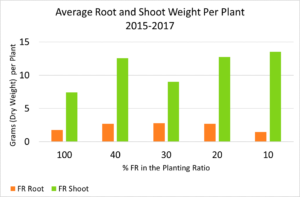
Table One: Average population by planting ratio, averaged across all three experimental years.
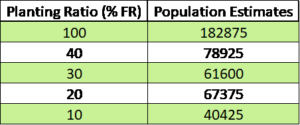
However, the data suggest the reduction in the 30% FR planting ratio may be due to reduced FR populations (Table 1). It is unclear why the population in this ratio is less than the population of the 20% FR planting ratio. However, this trend one again holds true not only in the averaged data but in individual experimental years as well. In addition to the reduced population, these plants also show reduced above ground biomass compared to other planting ratios with the exception of the sole crop of FR. This does suggest that in this ratio the intraspecific competition is still less than that of a sole crop.
Also somewhat surprisingly, the average roots biomass was smallest in the 10% FR planting ratio, but this ratio also exhibited the greatest shoot biomass. The root biomass was only slightly less in the 40% and 20% planting ratios, however the root biomass in these plots was more than double that of the 10% FR planting ratio.
HPLC
The HPLC data remains under further analysis although the extraction and HPLC protocol have been optimized. A substantial expense and difficult part of this experiment was adapting an analytical chemistry protocol for the considerations of a field-based experiment. Upon request, the author will share the detailed, step by step protocol for sample processing, storage, extraction, HPLC, and data analysis for researchers who desire to complete such an analysis. Due to the somewhat novelty of this approach, we are currently verifying results and will submit refereed publications in the fall of 2018.
Nematode Assessment
Nematode populations did not vary significantly by treatment (data not shown). The populations of free-living (bacterivores, omnivores, and fungivores) as well as plant-parasitic (herbivores) populations were found to vary naturally with the seasons. Plant parasitic nematodes identified in the experimental plots were Hoplolaimus, Tylenchus, Tylenchorhynchus, and Pratylenchus. None of the plant parasitic nematodes present were at or above the population threshold required to cause pathogenicity.
Nitrogen and Phosphorous Removal
Figure Five and Six: Total phosphorous and nitrogen, respectively, removed by treatment and crop, averaged across all three experimental years.
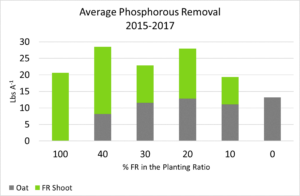
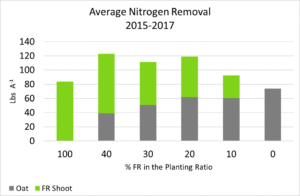
In this experiment, N & P are considered to be removed because the crops are grazed, as opposed to conventional cover crop treatments in which the crops capture nutrients and hold them until the next year. It is desirable to remove nutrients from crop production systems that use manure and harvest crops for feed. This both supports on-farm nutrient cycling and mitigates nutrient build-up and/or loss via leaching, run-off, or immobilization.
It is interesting, but not surprising, to see a nearly identical pattern of P and N capture across all treatments. Naturally, P and N are building blocks for cell division and growth, membrane production, as well as protein and energy synthesis. In this experiment, we find that there are roughly 4 times as many units of N acquired for each unit of P. Overall, all cover crop mixtures are more effective than sole crops of oat or FR in capturing both N & P. The FR and oat mixtures captured as much as 28 lbs of P/A and 220 lbs of N/A in an average of just 2.25 months with minimal disruption to the summer production season.
While nematode populations were not found to vary significantly in this study, it is critical to consider that none of the plant parasitic nematode (PPN) populations reached a point at which they would be considered to be a pest problem. Optimistically, we did not find that oat resulted in increased PPN populations, although this may not be the case for growers who are experiencing PPN pressure. Conversely, we did not find that FR suppressed PPN populations. However, a suppressive effect may be observable under conditions in which PPNs are problematic. Certainly, the literature suggests that other crops in the Brassicaceae family do produce biofumigant effects that can suppress soil pathogens, including parasitic nematodes. Our research does not detract from that fact, but does confirm the importance of selecting a crop bred for biofumigation if that is the intended outcome.
The unexpected variations in yield, population, and plant resource allocation to roots versus shoots reinforces the complexities of intercropping and crop mixtures. These results suggest the importance of testing and adjusting seeding ratios in order to produce the desired characteristics of the final, composite crop. This also reveals the importance of considering cover crop mixtures as intercrops. Studying cover crop mixtures with this consideration can help us improve mixture performance according to the desired outcome, regardless of if they are intended for dual-purpose use.
From the perspective of yield and crop composition alone, we would recommend planting forage radish at 20% its sole crop seeding rate with oat planted at 80% its sole crop seeding rate for beef producers and dry cows. In our experiment, this would be 77 lbs oat/A and 2.4 lbs FR/A. This planting ratio provides the greatest yield and a palatable 50/50 ratio of FR to oat. However, a concern that has been expressed by local dairy producers is that this ratio of FR to oat may affect milk flavor in actively milking cows. Until a direct milk assessment has been performed, a 10% FR to 90% oat ratio may be more amenable for early adopters.
Maximum N & P uptake can also be preserved in a dual-purpose cover cropping system. A 20% FR to 80% oat planting ratio captures the most N & P, and captures far more of both of these nutrients than either FR or oat alone. This suggests that there need be no trade-off when choosing to graze vs cover crop in a system that utilizes manure and harvests the cover crop for feed. Manure will continue to build SOM, as will the residual roots of component crops. Moreover, systems that apply manure in the spring do not require nutrients held over the winter by cover crops. Captured nutrients by these crops are better used in forage for over-wintering animals.
Education & Outreach Activities and Participation Summary
Participation Summary:
In 2016, we enrolled a local farm (organic, pasture raised beef) to experiment with dual-purpose cover crops harvested for feed. He will include fall FR and oat planting as part of a two year, dual-purpose cover crop rotation used to transition poor, rocky pasture into a productive perennial pasture following the rotation.
Preliminary results were presented at the Northeast Organic Farming Association Farm Visit, 8/11/16, (16 in attendance).
In 2017, we hosted two visits at our research farm for local schools (40 in attendance), and presented at a science-intensive course for college freshman at Springfield Technical Community College (30 in attendance). Topics for all three events included sustainable agriculture, cover cropping, the scientific method, and exposed students to local research efforts.
Also in 2017, we hosted the UMass Dairy Seminar (45 in attendance), and organized the Massachusetts Dairy Twilight Meeting (75 in attendance), and provided ongoing technical support, several farm visits, and forage and soil testing for our on-farm trial.
Two refereed publications, one fact sheet, and two newsletter articles are in prep for this research in addition to the following publications and presentations:
Publications
Brennan, R., Corcoran, S. G., Wick, R., Hashemi, M. (2018). Review: Biofumigant control of plant-parasitic nematodes. Ready
for submission.
Corcoran, S. G., Sadeghpour, A., Jahanzad, E., Keshavarz, A., Hashemi, M. (2018). Review: Intercropping in field crops.
Ready for submission.
Presentations
Corcoran, S.G., Hashemi, M. (2018). A Balancing Act: The Effect of Seeding Rate on Glucosinolate Production, Nutrient Capture, and Forage Suitability in Dual-Purpose Forage Radish and Oat Cover Crop Mixtures. Crop Science Annual Meeting. Baltimore, MD.
Corcoran, S.G., Hashemi, M. (2018). The Effects of Interspecific and Intraspecific Competition on Plant Secondary Metabolite Production. University of Massachusetts Amherst, Plant Biology Annual Symposium. Amherst, MA.
Corcoran, S.G., Hashemi, M. (2018). Ecological and Physiological Crop Dynamics in Grazing Season Extension. University of Massachusetts Amherst, Stockbridge School of Agriculture Research Showcase. Amherst, MA.
Corcoran, S.G., Hashemi, M. (2018). Working Two Jobs: Cover Crops For Animal Feed. Northeast Organic Farming Association, Summer Conference, Amherst, MA.
Forage Radish and Oat Flyer
Rehrig, E., Corcoran, S.G. (2016). The Role of Glucosinolates in Plant Defenses Against Insects. New England
Association of Chemistry Teachers, Professional Development Training. North Adams, MA.
Corcoran, S.G. (2016). Nuts and Bolts: Designing an On-Farm Research Experiment. University of Massachusetts Amherst Extension, Designing On-Farm Trials Event. Deerfield, MA.
Handout-How to Design an On-Farm Experiment; On-Farm Experiment Presentation
Project Outcomes
This work allowed for contact with dozens of individuals with the capacity to implement this research on farm and to expand upon this research experimentally; we also conducted outreach within the community as part of STEM curricula and Extension initiatives. We reached farmers applying for SARE farmer grants who sought to learn more about on-farm design. We reached high school chemistry teachers who aimed to include applied chemistry into their curricula. High school students and college freshman visited the farm and received in-field training.
Numerous farmers (both large and small scale), backyard producers, agricultural service providers, and researchers attended Extension and research presentations, workshops, and field days.
In response to legislative requirements surrounding fall manure application in MA, we developed a compatible cropping system that is environmentally, economically, and logistically feasible. We also sought out and received direct feedback from both dairy and beef producers alike, and incorporated their concerns and observations into this study.
This research agrees with and compliments work done by Julie S. Fine, M.S. (GNE14-080), which was also conducted in the Hashemi Lab. This work led to further, active investigation of manure digestate and how it is similar to, or different from, conventional manure as we used manure for 2/3 years and manure digestate in the third year.
Moving forward, we wish to further fine-tune GLS analysis and to assess sulfur (S) dynamics in intercropping with brassicas as S is critical in GLS formation. Furthermore, we intend to continue to study cover crop mixtures from an intercropping perspective so as to further elicit the complex dynamics that such mixtures present.
Information Products
- Forage Radish and Oats (Conference/Presentation Material)